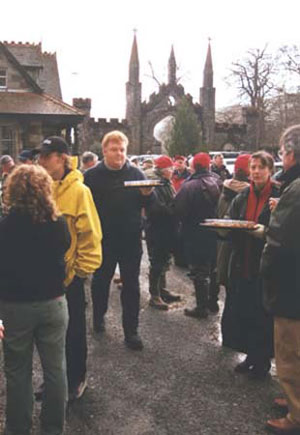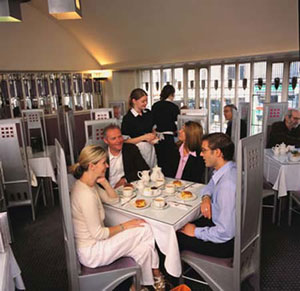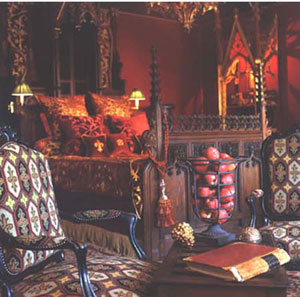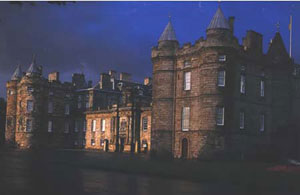 |
|
|
|
|
|
|
|
|
|
|
|
|
|
|
|
|
|
|
|
|
|
|
|
|
|
|
|
|
|
|
|
|
|
|
|
|
 |
|
|
|
|
|
|
|
|
|
|
|
|

|
THE SPORTING LIFE IN SCOTLAND
A Visit to the Highlands, Glasgow and Edinburgh The most prized of all game fish, salmon and trout, are the ones that inspire an image of an angler whipping a lure and line in serpentine arcs above a Scottish loch. Despite the cold, windy and rainy January weather, when the season opens sportspeople don bulky rubber waders up to their waists and try their luck in freshwater streams and lakes. You can fish all over the world, in Chile, Alaska, Canada, and Colorado, too. But there is nothing like the romance of being hosted by a "laird" on his stretch of water. Despite untold fishing opportunities in Scottish river systems, the names Tay and Tweed are poetry. "The Tay, meand’ring, sweet in infant pride, The Palace rising on its verdant side," was penciled on the parlor chimney piece at the Inn at Kenmore on the Loch Tay by Robert Burns in 1787.
In Kenmore, a village anchoring the eastern end of Loch Tay and the western point of the River Tay, the season begins on the 15th of January and closes in October. The calendar, not the climate, determines opening day for that is the point in time of a fish’s life cycle when it reaches its home pool to spawn. The 9 a.m. ceremony in the crowded square, witnessed by locals, visitors, officials and the press started with several short speeches and was preceded by dramming (like in sipping a wee dram). For the second year Dewar’s Whiskey sponsored the event. Located in the nearby town of Aberfeldy, the company, represented by red-capped employees, warmed the chilled assemblage by passing shots of White Label scotch in quaiches, silver doubled-handled drinking bowls. Accompanied by the Vale of Atholl Pipe Band dressed in traditional kilts, the group strolled to the water. Fiona Armstrong, a noted fisherwoman and reporter for Scotland’s Sky TV, poured a quaiche of Uisager Beathe (Gaelic for "water of life" or whiskey) over the brow of the first boat to wish the fishermen "tight lines." She then joined Andrew McTaggert, the laird, and a ghillie (fishing guide) to motor to the middle of the river. Armstrong cast the first line and several more with good sportswomanship, but with no success. Highland Adventure Safaris transported novice fishermen to the banks of the loch and provided ghillies, equipment and instruction. All were surprised at how quickly they took to the sport and how exhilarating were the few hours spent tossing the lines into the water at beats named Chinese, battery and castle. Paul Fishloch (call him Fish), a most unflappable teacher, said that patience is a required trait for fishermen.
The Tay District is promoting a conservation program. Fish may be tagged, photographed with the proud people who caught them and then released. On the 15th of January, the most successful angler, Jock Armstrong, bagged a 10-pounder at 4 pm, dusk in this locale. Although he had traveled to Aberfeldy with only his sports clothes, he was invited to the black tie (usually kilt rather than tux) celebration to receive the Redford Trophy. Andrew McTaggert owns many miles of land in the vicinity as well as Taymouth Castle. Started by the Campbell clan in the early 1800s, the castle, now empty and in need of extensive repair, does, nevertheless, house many unusual artifacts, including a library with a 24-carat gold ceiling. Victoria and Albert spent part of their honeymoon at Taymouth and the movie "Mrs. Brown" was filmed here. Located on the grounds of its Aberfeldy distillery, Dewar’s World of Whiskey is a Disneyesque interactive exhibit and museum. The eponymous Dewar’s was founded in the early 1800s by brothers Tommy and Johnny. After viewing a short visual presentation of the brand’s history in the auditorium, visitors step into "The Street" to learn more about the family and the evolution of the business. An audio guide explains the displays. A touch-tone computer challenges the user to combine the correct proportions of several ingredients to blend the perfect scotch. And if you can’t get it right, the man with the sly wit inside the computer will tease you. Dewar’s stylish advertising posters, often humorous and centering on the upper-classes, are on view as are family-owned art, furniture and other possessions. www.dewarswow.com Through smelling, eyeing and tasting at the store’s nosing and tasting bar, you learn what makes a great scotch. A tour of the distillery takes guests through the process of distilling and blending single malt whiskey.
The Kenmore Hotel, dating from 1572 and headquarters for the opening of the season, is said to be the oldest inn in Scotland. Sir Colin Campbell granted a lease to his servant Hay Stanes for "an honest hostelrie," which should at all times have sufficient bread and other provisions. While dining on a full Scottish breakfast—eggs, ham, black pudding, sausage, grilled tomato and mushrooms— you can enjoy a panoramic view including the historic arched bridge. The evening menu features some wonderful specialties such as venison, several types of salmon (what else), whiskey infused ice cream and good bread, as dictated by Sir Campbell. The haggis—don’t say ugh, yet—which we approached with apprehension, was served in Yorkshire pudding and was the best we tasted in Scotland. The bars and lounges are quintessentially British countryside. The simple rooms are adequate. Kenmore Hotel, The Square, Kenmore, Perthshire. Tel. 01887-830-205. Rates are reasonable. www.kenmorehotel.com Fishing information, www.fishingnet.com and www.highlandadventuresafaris.co.uk Kenmore lies midway between Scotland’s two great metropolises, Glasgow and Edinburgh, approximately 40 miles from each. Our journey away from the Highlands and its heathered hills took us to Glasgow, a city whose artistic riches and newly hip bar and club scene should help erase its dreary image as a center devoted solely to trade. Glasgow has awakened from a post-industrial slumber and discovered its worthy past, one made up of great swaths of parks, splendid museums and rows of stately Georgian and Victorian buildings. Dramatic new construction, the Science Centre and the "Armadillo Auditorium" near the River Clyde, has changed the landscape. The red double-decker "City Sightseeing Glasgow" bus makes 20 stops. On the drive through the fashionable West End and along Bythewood Square, a private park bounded by gracious townhouses, the grime fades and is replaced by proper British facades like the ones along the lovely streets of London and Dublin. Glasgow University, with its tower poking towards the sky, turreted roof, ancient walls and leafy campus projects the faithful appearance of an institute of higher learning that was established in the 16th century.
Art and architecture play a vital role in Glasgow’s developing tourist business. Who can match the neoclassical monuments of Alexander Thompson, the Victorian forerunner of Frank Lloyd Wright? His masterpieces were crafted in a deeply idiosyncratic Greek style with modern touches. Who can compete with Glasgow’s Art Deco nonpareil, Charles Rennie Mackintosh? He left a trail of work in museums, public buildings, furniture collections and private houses open to visitors. Major art museums are chock full of surprises. At Kelvingrove Art Gallery and Museum Goya, Botticelli and Rembrandt hang on the walls. Hunterian Art Gallery owns the largest gathering of works by James Abbott McNeil Whistler outside the United States. Southwest of the city in an airy exhibition hall in Pollok Park is the eclectic Burrell Collection. A testament to the exquisite taste of Sir William Burrell, a shipping magnet, it contains Chinese porcelain, medieval furniture, Greek and Roman sculptures, paintings by Rembrandt and Manet, Degas pastels and Rodin’s "The Thinker."
The Glasgow Cathedral, a pre-reformation building dates from the 13th to the 15th centuries. Its finest features are the stone choir screen and fan-vaulting around the crypt of St. Mungo. The Science Centre may soon draw the largest crowds in the city due to its absorbing exhibits. The centre has an IMAX cinema that shows four different films each day. The planetarium also runs four varied presentations daily. The Virtual Science Theatre takes audiences through molecules, around their own bodies and into space. Four floors of the Mall are devoted to 150 hands-on dynamic experiments. WHERE TO STAY IN GLASGOW The Tourist Board of Scotland has designated the granite and glass Hilton Glasgow, the tallest hotel in the country, as the only five-star accommodation in City Centre. Many patrons are business travelers and attendees at evening events who stay overnight. Americans with exacting standards might rate the hotel as four-star. Lack of in-room safes and the need to phone for a shoe shine weighs on the rating. The attractive modern décor is pleasant, the rooms and baths are more than ample and the large lobby holds enough seating for guests to gather. Glaswegians are most friendly and this trait is evidenced by a willing staff. Three facilities at the hotel stand out. The Living Well Health Club has many excellent services—pool, well-equipped gymnasium, sauna, steam room and solarium. The executive lounge for the concierge floors is open all day offering breakfast, snacks, tea, hors d’oeurve and continuous complimentary bar. Cameron’s, the hotel’s premier restaurant, is superb. Hilton Glasgow, 1 William St., Tel. 44-0-141-204-5555. Reasonable. www.hilton.com/glasgow WHERE TO DINE IN GLASGOW Cameron’s, at the Hilton, received the tourist board’s Four Medallion Award. The setting, a gracious dining room reminiscent of a Georgian home, is elegant; the service impeccable; and the cooking both beautiful to look at and full of grace notes. For example, rack of lamb, fork-tender beef fillet and saddle of rabbit came with a host of complementary tastes and textures. Appetizers and desserts were brilliantly inventive. The wines were beautiful and the sommelier did a credible job of helping us with our selections. This high-style cooking was as commendable as any you’ll find in Scotland. Cameron’s, Dinner, Monday to Saturday. Expensive. City Merchant was given a Two Medallion Award. What it has going for it are a warm and welcoming family of owners and a quaint and cheerful ambiance on one and one-half levels. Brick and wood-paneled walls are hung with old-fashioned equipment used in the country’s popular sports—ski poles, nets, fishing rods, binoculars and a stuffed grouse, the prize from a shooting expedition. The restaurant is very popular and on the night we were there only patrons with reservations were seated. An appetizer of woodland mushrooms, fresh ginger and honey was both earthy and had punch. Papaya accompanied smoked salmon and fish roe. Blackboard specials of grilled fish and choose your own sauce were poorly conceived. The four sauces were offered for meat and poultry, too, and did not combine well with the dry and bland fish. But the sticky toffee pudding was an over the top rendition of this favorite among British desserts. The cake was moist, spongy, and flecked with dates. And the sauce had an intense caramel flavor. City Merchant Restaurant, 97-99 Candleriggs.Tel. 0141-533-1588. Monday to Saturday.12:00 to 10:30. Expensive. www.citymerchant.co.uk
Charles Rennie Macintosh designed and decorated The Willow Tea Rooms, including the exterior, layout and furnishings. Opened in 1903, it stayed in business until 1928. During that heyday, the tearoom covered five floors. Because of the unique silver high back chairs and leaded mirror friezes done in Macintosh’s Art Deco style, seats in the Room du Luxe were the most desirable in the eatery. Although a store now occupies the street level, in 1983 Anne and David Mulhern faithfully reconstructed the remainder of the space. The menu is extensive and much like that of a luncheonette or diner in the States. Choose from a selection of sandwiches, salads, savories, muffins, desserts and drinks. Yes, afternoon tea is served, too. However, the name may have included Tea Rooms because the original owner was a temperance advocate and perhaps she wanted to alert the public that no spirits were served on the premises. Willow Tearooms, 21 Sauchiehall St., Tel. 0141-332-0521. Monday to Saturday, 9:30 to 4:30, Sunday, 12:00 to 4:30. Reasonable. www.willowtearooms.com
From Glasgow it is a mere 45-minute by train or one and one-half hours by car to Edinburgh, the hub of royal and bloody Scotland. In the heart of the old section a plug of volcanic stone, Castle Rock, serves as the pedestal for Edinburgh Castle, the stalwart symbol of Scottish existence. Very much a place of history, Queen Elizabeth was given a 21-gun salute at this site when in 1999 she opened the new Scottish parliament to return the country to partial self-rule. The castle has been layered and amended for centuries. A self-guided audio tour lasts four and one-half hours. The narrator could not otherwise spin out all the volumes about bravery, sieges, plagues and scandal. The castle being the most important attraction and the centerpiece around which the city spreads, you will be fortified with background material if you start your sightseeing here. The compactness of Edinburgh is a great asset. Scots are famous for being walkers and Edinburgh is a most walkable city. The openness of the people is legendary and we met more than one pedestrian who eagerly wished to converse. Stretching from the castle in a nearly straight line is The Royal Mile, a shop-lined cobblestone street. Assuming four different names in the process, it ends at The Palace of Holyrood House, the home of Mary Stuart and the residence where Her Majesty stays during official visits. On the same site is the dazzling new Scottish Parliament building, already a popular tourist magnet. The technologically advanced government body links to its constituencies through public electronic kiosks and home TVs. Across the road is Holyrood Park, five square miles of hills and open spaces.
At Charlotte Square the Georgian elegance and aristocratic harmony of New Town shines. Robert Adams’s architectural masterpieces, a monumental collection of five long palace-like facades, were built here. Georgian House at No. 7 is open part of the year. The National Gallery of Scotland draws an appreciative public to old masters such as Titian, Holbein, Rubens, Vermeer and El Greco. These are but a smattering of the exciting things to see in Edinburgh. A trip on the hop on and off bus provides a bird’s-eye description of many of the churches, palaces and historic houses and buildings. The ease of getting around on foot, not withstanding, our knowledgeable guide made the bus experience more than worthwhile. WHERE TO STAY IN EDINBURGH Since we don’t live in a castle, we don’t need a butler. Neither is on our radar screen. Nevertheless, we were tickled when we arrived at The Howard to be told that Ian would be our personal butler. Never mind, that we preferred to do our own unpacking, packing and so forth. It was fun to play Mr. and Mrs. Swell. Had we been in at tea time we might have had Ian serve us in the Drawing Room. The stay at The Howard is recalled as a treasured memory. Cobbled together from three terraced townhouses that were originally built in the 1820s for wealthy burghers, the Town House Company, owners of four boutique hotels, restored the patrician mien of this hostelry after acquiring it a few years back. There is no reception area in the front hall, the better to focus on a sweeping central staircase winding up to a high ceiling. The Howard disguises any trappings of a hotel. One feels rather as though he/she is in the home of a discerning collector who has amassed crystal chandeliers, antiques, leather-bound books, paintings and ceramic dogs to guard the massive marble fireplace. Our oversized suite impressed, too. It was furnished with a veneer-covered credenza, sofa table, desk, lamp tables, sofa and chairs, none of which had a commercial look, and artifacts that included a bust sculpture. It was homey in a luxe way. There was a half-canopied bed and the bathroom had top-notch fixtures—plus-sized deep tub and separate circular shower. The renowned Café Florian, located in Venice’s St. Mark’s Square, is opening a branch at The Howard. The Howard, 34 Great King Street, Tel. 0131 557 3500. Moderately expensive. www.thehoward.com WHERE TO DINE IN EDINBURGH During our stay at The Howard, Ian would have served the evening meal in the suite as most guests prefer their butler to do. We chose to eat in the restaurant, The Atholl. It turned out to be our own private dining room as we were the only ones taking dinner there that evening. Although, the restaurant does not advertise, it will accept outside patrons. All the food was exceedingly well prepared and exploded with tantalizing flavors. Char-grilled vegetables and smoked duck gave the meal a heady start. The salmon and beef were flat out great. And the lemon tart and chocolate torte were irresistible. Each perfect course helped create a most satisfying meal. The Atholl at The Howard, Dinner 7 to 9, Monday to Sunday. Moderately expensive. History, seductive food and a beguiling atmosphere make The Witchery by the Castle one of the most sought after reservations in town. The storied 1595 building in Boswell’s Court borders on the end of Royal Mile near the castle. The proprietor offers three singular experiences in the three dining rooms. The oak-paneled walls, hung with tapestries, mirrors and carvings in The Witchery, the most formal space of all, were rescued from a cathedral and a French chateaux. Gilded ceilings, somewhat like those at The Palace of Holyrood, antique leather screens and rich burgundy seating are appropriate to the heritage of the stone edifice. The Secret Garden has its own splendid décor and is lit solely by candles. The carved ceiling, painted with tarot symbols is similar to the Museum of Scotland’s Rossend ceiling. Three room-height fan windows lead to a topiary- and urn-filled terrace. The Secret Garden has its own mascot, a mischievous bagpipe-playing cherub, whose image is reproduced throughout. A sister property, The Tower atop the landmark Museum of Scotland, skips ahead a few centuries into a sleek and contemporary mode with aluminum furniture, a mosaic bar and tweed banquettes. Edinburgh’s first rooftop restaurant and terrace, it has spectacular views of the skyline and castle. The menu at The Witchery offers a mix of adventurous and traditional Scottish dishes. Warm home-smoked salmon was the best preparation of the fish we had in all of Scotland. The filet had been cooked over wood, which imparted a delicate smokiness. Roasted celeriac and curried apple soup was tangy and a fit antidote for a cold day. The wild mushroom crust on the Aberdeen Angus beef gave it a quirky twist. The accompaniment, balsamic roasted root vegetables, perked up this entrée. Confit of wild rabbit was nicely paired with two sides—Savoy cabbage and bacon and mashed potatoes, seasoned with garlic and parsley. Desserts are mouth watering. The plate of puddings included a torte, parfait and crème brulee of varying flavors. To satisfy a yen for sticky toffee pudding, you’ll have to go to The Tower where a heavenly version is served with whiskey and brown-bread ice cream. This restaurant has a different menu from the dining rooms at The Witchery by the Castle. Ask reception to show you a few of the six guest suites, decorated to the nines in dramatic Baroque style. Each is named, and contains many unusual and colorful furnishings purchased by the owner on trips around the world. The Witchery by the Castle, Castlehill, The Royal Mile. Lunch and dinner. Monday to Sunday. Tel. 0231-225-5613. Moderately expensive. www.thewitchery.com Tower Restaurant, Museum of Scotland, Chambers Street, Tel. 0131-225-3003. Lunch and Dinner, Monday to Sunday. Moderately expensive. www.tower-restaurant.com Winter 2002-03 |
||||||||||||||||||







